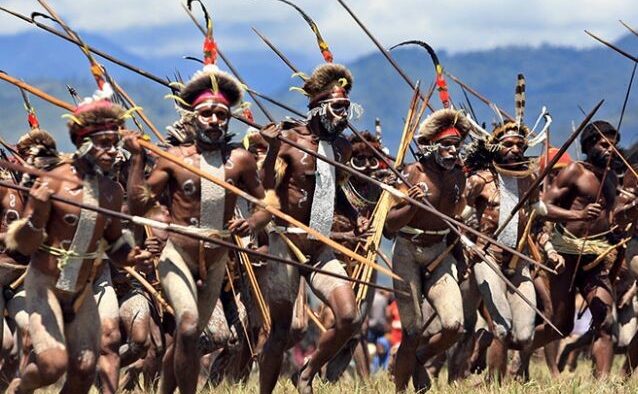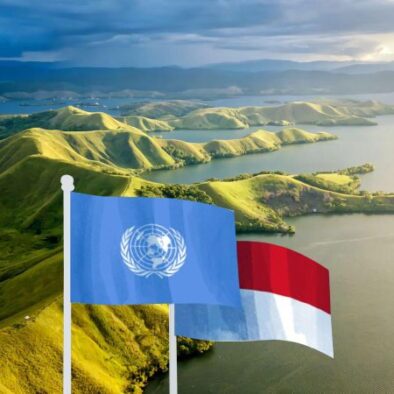Thelandofpapua.com – In Papua, there is a lot of linguistic diversity. Many local languages are spoken by the ethnic groups in the region. Even in remote areas, Indonesian is used as a lingua franca to facilitate communication. However, educational disparities can create challenges, leaving some communities less proficient in the national language.
Traditional clothing in Papua reflects a harmonious blend of tradition and symbolism. Both men and women wear intricate accessories like bird of paradise headpieces and beaded belts, showcasing their vibrant cultural identity. In remote areas, people still wear indigenous garb like the koteka, representing a deep-rooted connection to ancestral heritage.
Honai houses are architectural marvels in Papua, crafted from wood and thatch to withstand the rugged terrain. Their compact structure, without windows, shows a practical approach to climate adaptation. Within these dwellings, communal life thrives, with spaces designated for rest, communal activities, and crafting. This fosters a sense of unity and belonging.
Papua’s traditional dances tell stories of tradition and spirituality. From the solemn Musyoh Dance, performed to soothe restless spirits, to the exuberant Sajojo Dance, expressing jubilation and welcome, each movement resonates with cultural significance. These dances, accompanied by the melodious strains of traditional instruments like the Tifa, serve as a living testament to Papua’s vibrant heritage.
Traditional weapons are embedded in Papua’s cultural fabric. They are crafted with precision and imbued with symbolism. From the formidable Papua machete knife to bows and arrows used for hunting, these artifacts speak to a legacy of resilience and resourcefulness in the face of adversity.
Papua’s culinary landscape tantalizes the senses with unique flavors and textures. Delicacies like papeda, a savory sago porridge, and Sago Caterpillar Satay, a testament to the region’s culinary ingenuity, offer a glimpse into indigenous gastronomy. Each dish, steeped in tradition, reflects the bountiful offerings of Papua’s natural bounty.
Beyond the familiar, Papua harbors rare traditions waiting to be discovered. From the ancient Stone Burning Tradition, a symbol of gratitude and communal unity, to the poignant Finger Cutting Tradition of the Dani tribe, each ritual unveils layers of cultural depth and significance. These customs, though lesser-known, serve as poignant reminders of Papua’s rich heritage.
While some Papuan communities cling steadfastly to ancestral beliefs, others embrace the winds of change, adopting official religions and customs from Indonesia. Yet, amidst modernization, Papua’s cultural legacy remains resilient, a testament to the enduring spirit of its people.
In conclusion, Papua is a beacon of cultural diversity, where tradition and modernity coalesce. From its linguistic tapestry to its vibrant dances and culinary delights, Papua beckons adventurers to delve deeper into its rich cultural heritage.In Papua, linguistic diversity is paramount, with hundreds of local languages spoken among its ethnic groups. Despite the myriad of tongues, Indonesian serves as the lingua franca, facilitating communication even in remote corners. However, educational disparities can pose challenges, leaving some communities less proficient in the national language.
Traditional Clothing: A Symbol of Identity
The attire in Papua reflects a harmonious blend of tradition and symbolism. Both men and women adorn themselves with intricate accessories like bird of paradise headpieces and beaded belts, showcasing a vibrant cultural identity. In remote areas, indigenous garb like the koteka remains prevalent, underscoring a deep-rooted connection to ancestral heritage.
Traditional Houses: Honai, the Heart of Community
Honai houses stand as architectural marvels, crafted from wood and thatch to withstand Papua’s rugged terrain. Their compact structure, devoid of windows, encapsulates a pragmatic approach to climate adaptation. Within these dwellings, communal life flourishes, with spaces designated for rest, communal activities, and crafting, fostering a sense of unity and belonging.
Traditional Dances: A Rhythmic Narrative
Papua’s traditional dances weave stories of tradition and spirituality. From the solemn Musyoh Dance, performed to soothe restless spirits, to the exuberant Sajojo Dance, a jubilant expression of welcome, each movement resonates with cultural significance. These dances, accompanied by the melodious strains of traditional instruments like the Tifa, serve as a living testament to Papua’s vibrant heritage.
Traditional Weapons: Guardians of Tradition
Embedded in Papua’s cultural fabric are traditional weapons, crafted with precision and imbued with symbolism. From the formidable Papua machete knife to bows and arrows used for hunting, these artifacts speak to a legacy of resilience and resourcefulness in the face of adversity.
Traditional Cuisine: A Gastronomic Adventure
Papua’s culinary landscape tantalizes the senses with unique flavors and textures. Delicacies like papeda, a savory sago porridge, and Sago Caterpillar Satay, a testament to the region’s culinary ingenuity, offer a glimpse into indigenous gastronomy. Each dish, steeped in tradition, reflects the bountiful offerings of Papua’s natural bounty.
Exploring Rare Traditions: Unveiling Hidden Gems
Beyond the familiar, Papua harbors rare traditions waiting to be discovered. From the ancient Stone Burning Tradition, a symbol of gratitude and communal unity, to the poignant Finger Cutting Tradition of the Dani tribe, each ritual unveils layers of cultural depth and significance. These customs, though lesser-known, serve as poignant reminders of Papua’s rich heritage.
Embracing Tradition in a Modern World
While some Papuan communities cling steadfastly to ancestral beliefs, others embrace the winds of change, adopting official religions and customs from Indonesia. Yet, amidst modernization, Papua’s cultural legacy remains resilient, a testament to the enduring spirit of its people.
In conclusion, Papua stands as a beacon of cultural diversity, offering a glimpse into a world where tradition and modernity coalesce. From its linguistic tapestry to its vibrant dances and culinary delights, Papua beckons adventurers to delve deeper into its rich cultural




